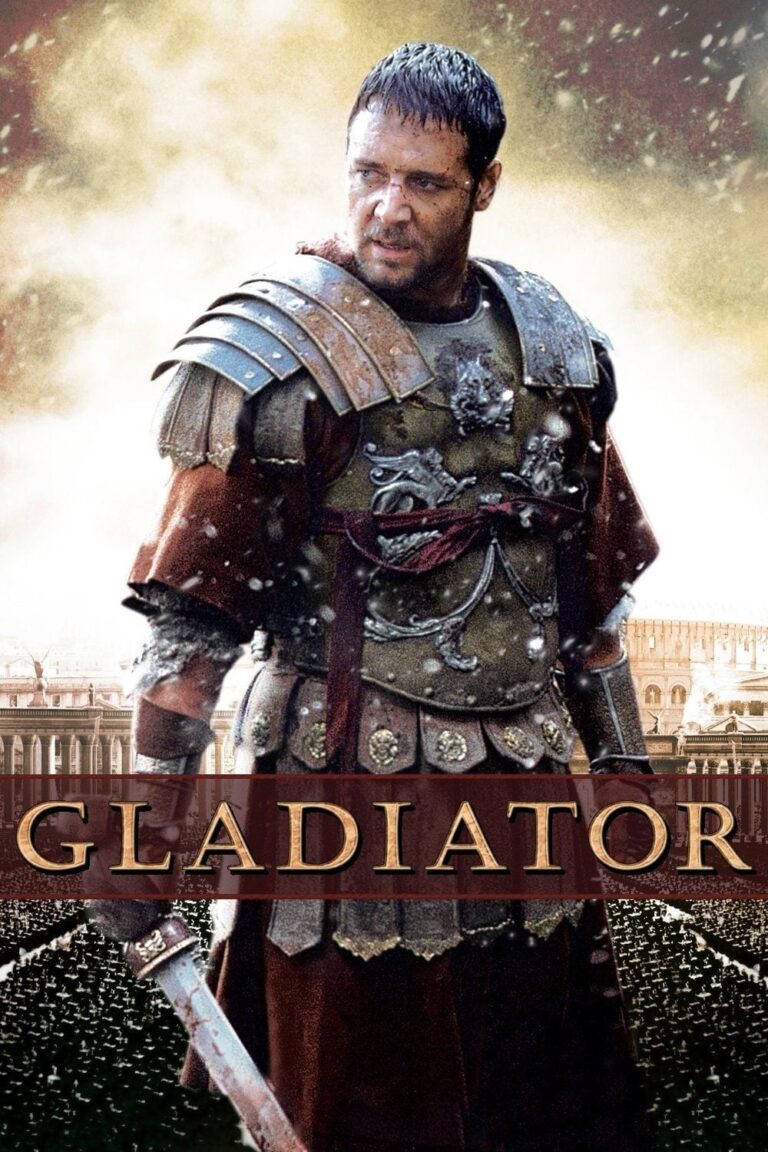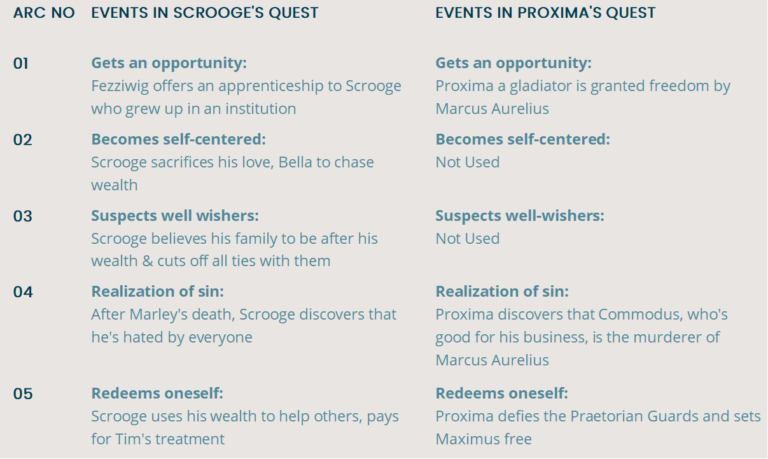
Gladiator
3 unique quests that accompany the quest of Vengeance
EST V ACT domestic box office revenue
$143-175 V $188MM
Mythosis universal quests used
4
Audience appeal
9.38% – 11.46%
Script Score
0.33
Gladiator directed by Ridley Scott gladiator 2000 follows the story of a Roman General’s relegation to slavery, rise through the ranks of the gladiators and his revenge. The story explores the basic human desires of Preservation, Vengeance, Accumulation and Family. Mythosis, harnesses mythological tales to extract the unique plot structure of Gladiator. The plot structure uncovers what makes the story engaging and also exposes the gaps.

1. The invisible plot structure of Gladiator
1A. The script of Gladiator borrows 98% of its events from 4 mythological tales
Maximus’ quest is driven by the desire to punish offenders and mirrors the tale of Dron from Hindu mythology. Both Dron and Maximus are betrayed and humiliated by their friend and seek to avenge themselves.
Commodus’ quest is driven by the desire to survive a threat and mirrors the tale of Kans from Hindu mythology. Both Kans & Commodus fail to kill their nemesis and pay the price.
Proxima’s quest is driven by the desire to own and mirrors the tale of Valmiki from Hindu mythology. Both Valmiki & Proxima are self-centred but have a change of heart and sacrifice their interest.
Lucilla’s quest is driven by the desire to protect loved ones and mirrors the tale of Demeter from Greek mythology. She is helped by Maximus and the Senate to protect Lucius from Commodus. This is similar to Zeus helping Demeter free Persephone from Hades.
Juba & Hagen have underdeveloped quests of Honour. The quests of Aurelius, Gracchus & Quintus are subsumed in the quests of Maximus & Commodus. None of the other characters have any quest.
NOTE: Detailed mirroring of each character’s primary quest to their respective mythological tales is in section “3A. Quests of characters and their mythological counterparts”
Mythosis plot structure
#859,987
Tales interweaved
Dron, Kans, Valmiki & Demeter
I. How does interweaving mythological tales lead to infinite story plots?
II. Can the pursuit of a Desire have more than one quest?
2. The potential of Gladiator’s plot structure: $143 – 175MM
The interweaving of 32 mythological tales can generate a billion unique stories. By using these 32 tales, we can extract the plot structure of any story across various genres. Our study of blockbuster, hit, and flop plot structures led to the discovery of the Mythosis Code, a set of principles for creating compelling stories. The plot structure of a story is analyzed to see how well it adheres to these storytelling principles.
2A. Plot structure evaluation of Gladiator
- All Blockbusters have at least 3 universal quests. Gladiator uses 4 universal quests of Vengeance, Preservation, Accumulation and Family.
- In Blockbusters, each universal quest is mirrored by ONLY ONE character. Maximus mirrors the universal quests of Vengeance. Commodus mirrors the universal quest of Preservation. Proxima mirrors the universal quests of Accumulation whereas Lucilla mirrors the universal quests of Family.
- Every Blockbuster character borrows at least 35% of the universal quest. Maximus borrows 40% of the events from the quest of Vengeance. Commodus borrows 34% from the quest of Preservation. Proxima borrows 19% of events from the quest of Accumulation whereas Lucilla borrows 10% of events from the quest of Family.
- Blockbusters have a quest interweaving threshold of 0.5. Interweaving occurs when events of 2 quests occur simultaneously in the story. The quest interweaving score of Gladiator is 0.50 and is at par.
An example of interweaving the quests of Maximus & Commodus:

2B. Box office revenue estimation of Gladiator
Gladiator’s plot structure has two very powerful character quests of Maximus & Commodus. A third character quest with sufficient depth would unlock its hidden potential.
The Script Score measures a plot structure’s adherence to the four principles of Mythosis Code. We use the Script Score to estimate a movie’s audience appeal & revenues. Blockbuster plot structures have a score of at least 0.64 and appeal to 20% of the audiences.
Script Score
0.33
Audience appeal
9.38% - 11.46%
I. How is Mythosis Code used to estimate revenues?
II. Aren’t box-office revenues influenced by several factors beyond just the story plot?
3. The ideal plot structure of Gladiator
We have identified 32 mythological tales, the superset of all tales across cultures. The quests of these tales have also recurred over time periods. They represent human behaviours that are deeply embedded in our shared memories. Each tale is the richest expression of the pursuit of a human desire. The tales have a unique pattern of events spread over 5 major arcs.
Mapping a character’s quest to the relevant mythological tale reveals the gaps in their quest, if any. Plugging these gaps with the missing events deepens the character quest. The missing events also provide an opportunity for interweaving the various quests. These events strengthen the story and unlock its hidden potential.
3A.Quest of characters and their mythological counterparts
Quest 1: Maximus mirrors the universal quest for Vengeance
Maximus’ desire for Vengeance stems from the need to punish offenders. The tale of Dron from Hindu mythology is the universal quest for Vengeance.

Quest 2: Commodus mirrors the universal quest for Preservation
Commodus’ desire stems from the need to survive a threat. The tale of Kans from Hindu mythology is the universal quest for Preservation.

Quest 3: Proxima mirrors the universal quest for Accumulation
Proxima’s desire for Accumulation stems from the need to collect and own. The tale of Valmiki from Hindu mythology has a robust expression in Dicken’s character of Scrooge which is the universal quest for Accumulation.

3B.Gaps in the current plot structure
The gap in Gladiator’s plot structure is due to a weak third quest.
3C.Unlocking the hidden potential
Contact: anandshiv@usemythosis.com
Contact us for Gladiator’s plot structure #859, 987
Tags: Dron, Kans, Valmiki, Demeter, Accumulation, Preservation, Vengeance, Family, Ridley Scott, David Franzoni, John Logan, William Nicholson, DreamWorks Pictures, Universal Pictures, 2000
